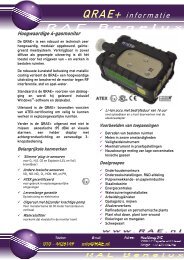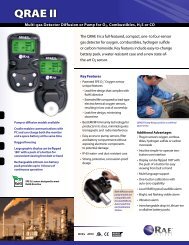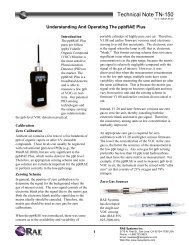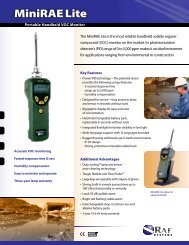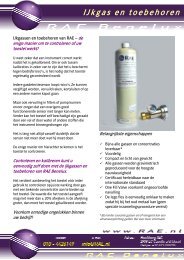You also want an ePaper? Increase the reach of your titles
YUMPU automatically turns print PDFs into web optimized ePapers that Google loves.
Technical Note TN-163<br />
rev 5 ab.05-07<br />
Pump<br />
Start by replacing the filter, and then work on cleaning<br />
the internal parts of the instrument. Loosen the two<br />
screws on the back of the instrument and remove the<br />
top housing cover. Unplug the battery. If you have a<br />
black-box MultiRAE, you have access to the gas plate,<br />
pump and sensors now. If you have a silver-box<br />
MultiRAE, you still need to unscrew the four screws<br />
holding the gas plate to the instrument. After loosening<br />
the four screws, pull the gas plate off of the silver stand-<br />
plugged into the<br />
offs. Unplug the tubing from the pump and the wiring<br />
PCB.<br />
To clean the tubing, remove both pieces of tubing<br />
from<br />
the instrument and the gas plate and immerse it in<br />
methanol. Agitate it by hand or in an ultrasonic bath.<br />
Remove it and let it dry overnight. The black<br />
MultiRAE does not have tubing, but there are O-rings<br />
in the adapter attached to the tubing. Make sure there is<br />
no dirt in the adapter or O-rings by removing the pump<br />
from the top housing, and unplug the pump from the<br />
adapter. Remove all eight O-rings and inspect the<br />
adapter and O-rings. Clean the adapter and O-rings<br />
with methanol. Dry the O-rings with a piece of the lens<br />
tissue that comes with lamp-cleaning kit. Clean the<br />
pump by removing the four screws that hold the head to<br />
the diaphragm. Use a cotton swab dipped in methanol<br />
to clean all surfaces, including the diaphragm.<br />
Reassemble the pump and set it aside to dry for 5<br />
minutes. Now that everything is removed from the gas<br />
plate, clean the gas plate by pushing air or methanol<br />
through the airflow path. Allow it to dry overnight.<br />
The PID sensor<br />
The PID sensor is covered by a shielding cover that<br />
needs to be removed. This silver cover can be dipped in<br />
methanol to be cleaned. To clean the sensor, remove it<br />
from the instrument and immerse it in lamp-cleaning<br />
solution (anhydrous methanol) in a small beaker or<br />
baby food jar.<br />
Agitate it by hand or in an ultrasonic cleaner. Fill the<br />
ultrasonic cleaning bath with water. Place the beaker<br />
containing the sensor into the water bath of the<br />
ultrasonic cleaner. The ultrasonic waves pass through<br />
the water and container and assist in cleaning the<br />
sensor. The lamp-cleaning solution in the jar can be<br />
reused a few times until it becomes dirty. Remove<br />
the PID sensor and let it dry for at least a few hours,<br />
and preferably overnight (warm but not hot air will<br />
speed the drying process).<br />
Caution! Do not overheat the sensor!<br />
It is very important to blow or shake out any residual<br />
lamp-cleaning solution from the sensor before letting it<br />
air dry. Otherwise, some of the dirt that was just<br />
extracted into the cleaning solvent could be deposited<br />
back onto the sensor components as they dry. Reinstall<br />
the clean, dry sensor into the MultiRAE. Exhale into<br />
the instrument and check the response. If it shows no<br />
response to the moisture in your breath, calibrate the<br />
instrument and return it to service.<br />
EntryRAE<br />
If moisture problems still persist, contact the RAE<br />
Systems Service Department at 888-723-4800.<br />
5<br />
RAE Systems Inc.<br />
3775 N. First St., San Jose, CA 95134-1708 USA<br />
Phone: +1.888.723.8823<br />
Email: raesales@raesystems.com<br />
Web Site: www.raesystems.com



